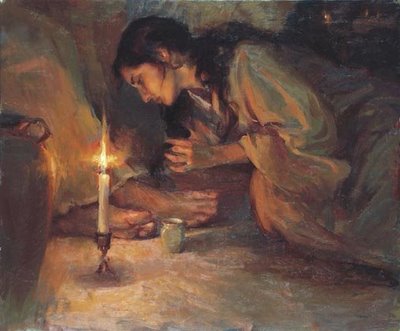The women who anointed Jesus feet and their typology

The Women who Anointed Jesus and their typology
While comparing the similarities in all four gospels of the women who anointed Jesus, we note a distinguishing contrast of each incident! Many have casually read through each account and have assumed that they are different views of the same occurrence. However this is not true, except for the gospel of Matthew and Mark who approach the same story from a slightly different angle. To overlook the subtle yet obvious differences, is to miss the spiritual significance of what the Holy Spirit is trying to convey to us. Focusing in with the microscope of God’s Spirit on all four gospels, we can catch a glimpse of the mind of Christ and His desire to depict the nature of His bride.
These three events suggest that there is a setting apart of the bride from that of the Church. We shall also see how each account will help define for the believer there perception of Yeshua as either husband or master. The immoral woman in Luke’s gospel represents the Gentile bride. Mary of Bethany the sister of Martha and Lazarus in John’s gospel symbolizes the Jewish bride. Then there is the woman with no name in Matthew and Mark’s gospel who typifies the Church consisting of both Jew and Gentile. Let’s look at each account to draw out the spiritual meaning and categorize them to uncover the characteristics of those who answer the call to be the bride of Christ.
The first account of the anointing in order of its chronology happened in the region of Galilee at the house of a Pharisee named Simon. Luke’s gospel makes it apparent that this takes place early on in Jesus’ ministry. While at Simon’s house, a woman who is addressed as an immoral woman comes uninvited into this gathering and begins to anoint Jesus’ feet with her tears and wipes them with her hair. She also pours perfume on His feet. The Pharisee says to himself, “if Jesus was a prophet of God He would have known that this woman was a sinner and would not have let her touch Him”, Luke 7:36-:39.
Luke’s gospel seems to suggest that this woman may be a Gentile. In his writing he refers to her as a “sinner”. This was the mind set of the Jews because God had only made a covenant with the Jewish nation and separated them from all the other peoples of the earth to be His very own. Note how Paul argues his point of grace apart from law comparing himself to that of the Gentiles, “We who are Jews by birth and not Gentile sinners know that a man is not justified by observing the law, but by faith in Jesus Christ” Gal 2:15. John the Baptist also addresses this Jewish conception when he spoke to the people at the river Jordon saying abrasively “You brood of vipers! Who warned you to flee from the coming wrath? Produce fruit in keeping with repentance. And do not begin to say to yourselves; we have Abraham as our father” Luke 3:7-8. In this passage John re-enforces that all men are sinners regardless of their heritage contrary to what the Jews believed that only they were accepted by God and Gentiles were sinners. One last observation to consider about this women is the fact that she is the only one who anoints Jesus’ feet with tears of sorrow and Jesus’ remark to Simon in regards to her many sins points to the Gentile believers many transgression and disregard for God’s Law.
The second anointing Jesus receives takes place six days before His crucifixion when He arrives in Bethany and goes to a dinner in His honor that is hosted by Martha, Mary and Lazarus. Mary takes a pound of pure nard that is worth one year’s wages and pours it on Jesus’ feet while wiping the perfume with her hair John 12:1-3. Mary who is from Bethany symbolizes the Jewish people. Bethany means house of unripe figs and speaks of the nation of Israel as late bloomers in recognizing Jesus as Yeshua Chatan, Jesus the Bridegroom. There are no tears shed by Mary as seen in the immoral women. The cost of the anointing was higher for Mary than the immoral women because it symbolizes the price the Jews will pay before they accept Jesus as the Bridegroom.
The last anointing took place two days before Jesus’ crucifixion by an unnamed woman. While in Bethany at the house of Simon the leper, a women comes with an alabaster box of pure nard and anoints Jesus’ head Mark 14:1-3 & Matt 26:6-7. She is the only one who does not anoint His feet. Notice in the two previous accounts neither woman anointed Jesus’ head. The cost of the unnamed woman’s anointing was one year’s wages like that of Mary. Both the price and anointing of the head personify those who accept Jesus only as Lord and King. All the kings in the Old Testament were anointed with nard poured on their heads in acknowledgement of their kingship.
Looking deeper into all accounts we can extract precious spiritual nuggets that unveil the nature of the bride. In the first two accounts we have both women anointing Jesus’ feet but neither anoints His head. This act testifies to the character of the two women and their understanding of Jesus as the bridegroom God. In Ruth 3:3-5, Naomi sends her daughter-in-law to the threshing floor of her kinsmen redeemer, Boaz. She was instructed to lie down at his feet. When a woman lies down at a man’s feet she was saying in essence, “Cover me with your garment and I’ll be your bride”, see also Ezekiel 16:8. To anoint ones feet suggest even a more intimate nature. The word “foot” singular in Hebrew is “regel” Strong’s 7270 and is used as a euphemism for pudenda. Another strong indication that these two women understand their call to be the bride is the fact that they let down their hair in the presence of men. Women wore their hair up in public or kept it covered. Hair was considered sensual and was only let down in the presence of ones husband. The act of letting their hair down suggested they acknowledged Jesus as their Husband and He accepted their gesture.
In the story of the immoral woman we see that she anoints Jesus first and with perfume that has no value placed on it. Both the early account and price of the anointing; points to the Gentiles acceptance of Jesus as the Bridegroom God before the Jew and their offer of forgiveness being freely given. However, Mary the Jewish Bride and her anointing late in Jesus’ ministry with costly nard points to the Jews who will at the end of this age accept Jesus as the Bridegroom but with a high price. Lastly, the unnamed woman and her anointing of His head with costly nard points to the Church who does not see Jesus as the Bridegroom or rejects it but does accept Him as Lord and King. The cost will be high for those at the end time who will go through the tribulation as seen in Revelation.








